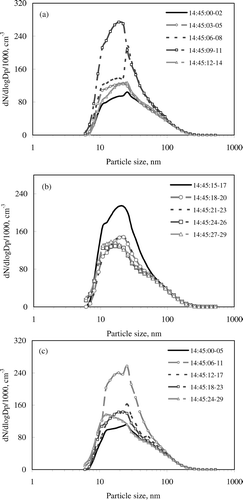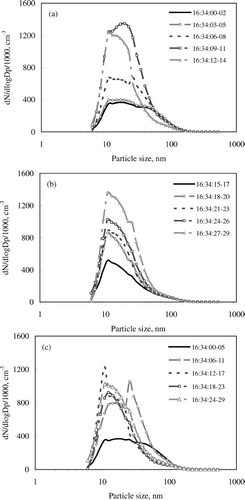Abstract
The availability of high time-resolution (1 s full spectrum scan) particle sizers permitted atmospheric researchers to scrutinize the characteristics of ultrafine particles in rapidly varying (perhaps, random) high concentration environments such as roadside, on-road, and tunnels. These data also revealed possible artifacts associated with the slower (∼ 30 s or more) scanning sizers when used in this kind of environment. This study discusses sampling rate artifact problems based on simulations using 1 s Engine Exhaust Particle Sizer data taken on a mobile platform.
1. INTRODUCTION
Sampling artifact has been a much studied and reported aerosol research topic in recent years. Almost all of the reports have to do with the volatility of the components, be they inorganic or organic, in the particulates. In the advent of faster and faster real-time size-segregated ultrafine particle counters (scanning instruments included), one more possible artifact caused by instrument sampling rate deserves attention. It is common knowledge that when the process parameter variation rate is faster than the sampling rate, aliasing results. Although the individual measurements (magnitude) may be correct, the characteristics of the dataset thus obtained can be entirely different from the original signal and therefore can be erroneous or even meaningless. In is the classic example cited in numerous process control textbooks (CitationCoombs 1995) when a sine wave is measured by an instrument that is three times slower than the frequency of the signal. The resulting wave has a much lower frequency and is out of phase with the original signal. When similar concept is applied to the measurement of particle size distributions in rapidly varying (perhaps, random) environment such roadside, on-road, or inside tunnels, a slower particle sizer could experience similar situations.
FIG. 1 Aliasing caused by instrument sampling rate slower than the signal. The sampling rate is three times slower than the signal.
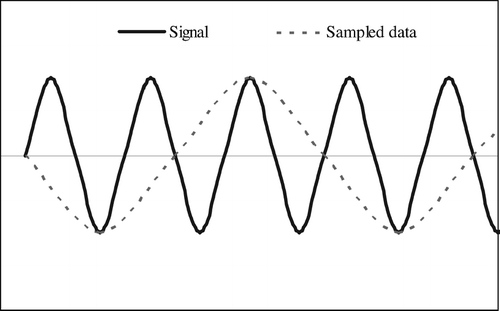
While measurements of particle size distribution of submicron particles were first reported in the 1970s (CitationKnutson and Whitby 1975), the impetus of modern real time size distribution measurements was provided by CitationWang and Flagan (1989) with the introduction of the scanning operation of the differential mobility analyzer. Adopting Wang and Flagan, TSI developed the first “real-time” particle sizer (Scanning Mobility Particle Sizer, SMPS) that continuously scans the classifier voltage while recording detected particles into a sequence of mobility channels, thereby enabling the determination of size distributions of ultrafine particles in as little as 50s. This allowed the measurement of rapidly changing aerosols (CitationCollins et al. 2002). Since then, SMPS has been widely used to characterize vehicular particles in engine test-bed studies (CitationBurtscher 2005) as well as for ultrafine particle measurements at roadside, on-road, and in tunnels (CitationBukowiecki et al. 2002a, Citationb; CitationMolnár et al. 2002; CitationZhu et al. 2002a, Citationb; CitationBukowiecki et al. 2003; CitationGidhagen et al. 2003; CitationSturm et al. 2003; CitationKittelson et al. 2004; CitationGramotnev and Gramotnev 2005; CitationDesantes et al. 2005; CitationKuhn et al. 2005). Whether a 30-s scanning particle sizer is fast enough to measure the full-spectrum particle size distribution in rapidly varying (perhaps, random) high concentration environments such as roadside, on-road, and tunnels, has not been addressed. Recently, individual researchers custom-improved the scanning speed of SMPS and using such a fast SMPS, CitationWang et al. (2002) made size distributions of particles from an aerosol generator in 3-s with minimal mixing-induced distortions, and the size distribution of coagulation aerosols could be effectively recovered by deconvolution of scans as short as 1 s. CitationShah and Cocker (2005) made size distributions of particles from an aerosol generator in 2.5 s and excellent agreement is obtained for the size distributions between the fast SMPS operating at 2.5 s and the traditional SMPS (300 s). However, none of these instruments are commercially available, thus the bulk of literature is still based on 30-s SMPS spectra. Upon the introduction of the Engine Exhaust Particle Sizer (EEPS, TSI, Inc.) in 2004, which can yield a 32-channel size distribution measurement in parallel in 1 s, it becomes possible to discuss the sampling rate issue of the particle sizers in the range of 1 to 30 s. There are two facets: (1) sampling speed vs. sample variation rate, and (2) the consequences of sequentially scanned and parallel measured particle size distributions. We report our findings here based on our analysis of EEPS data on board of the Mobile Real-time Air Monitoring Platform (MAP).
2. EXPERIMENTAL
Detail specifications of MAP can be found in CitationYao et al. (2005). Briefly, the following instruments were onboard: Engine Exhaust Particle Sizer (6.5–560 nm, 1 s per 32-cut scan), an Electrical Low Pressure Impactor (ELPI, particle size distribution in 12 cuts ranging 0.03–20 μ m at a scan rate of 1 s) (Dekati, Ltd.); stand-alone gas analyzers for SO2, NOx, CO, and O3 (API, Inc.); an aethalometer (Magee Scientific) to measure black carbon; an automatic weather station; a composite global positioning system (GPS)/digital compass/speedometer navigation system. The description and theoretical analysis of EEPS are given by CitationTammet et al. (2002), CitationJohnson et al. (2004), and CitationBiskos et al. (2005) and field measurements using EEPS are reported by CitationYao et al. (2005) and CitationJacobson et al. (2005). EEPS is designed to measure particle size distributions based on multiple high sensitivity electrometers that allow the simultaneous concentration measurements of particle sizes as fast as 10 size distributions per second (CitationJohnson et al. 2004). While the EEPS reports concentrations inferred from parallel electrometer measurements in intervals as short as 0.1 s, we have been unable to locate direct measurements of its time response, that is, of the RC time constants of the electrometers. The EEPS has 22 electrometers from which, through data inversion, its analysis software reports concentrations in 32 channels (16 channels per decade). In contrast, the SMPS counts particles into as many as 167 time bins to yield as many as 64 channels per decade. MAP with a forward-pointing isokinetic unidirectional sampling probe is designed to make measurements at 50–70 km hr− 1. With an omni-directional PM10 inlet made by R&P Corporation (US), MAP can be used as a conventional stationary monitoring facility. The inlet is on the top of MAP and is ∼ 4 m above the ground level.
In this study, ultrafine particle concentrations and number concentration size distributions in vehicular plumes (gasoline and diesel) were measured using the EEPS in various environments in Hong Kong:
| 1. | Parked at roadside as a stationary station, | ||||
| 2. | On roads, and | ||||
| 3. | In tunnels when MAP was traveling at an average speed of ∼ 60 km hr− 1. | ||||
The sampling periods were 23 and 27–28 September and 7–8, 11–14 October 2004. The measurements started at 10:00 and ended at 16:00. The data taken on 7 October are used in this discussion as examples.
3. RESULTS AND DISCUSSION
In only the number concentrations of the 10.8, 22.1, 29.4, and 52.3 nm particles are shown (to avoid cluttering of the figure) for a period of three minutes in early afternoon on 7 October when MAP was parked as a roadside station in Ngau Chi Wan. The influence of passing vehicles is easily seen. The size distributions at four different times are shown in (labeled as A, B, C, and D) when large concentration variations are encountered. Two types of distributions are observed, a dominant 10 nm mode and a minor 50 nm mode, and a dominant 22 nm mode and a minor 10 nm mode due to relatively stable ultrafine particle sources.
FIG. 2 Ultrafine particle number concentrations and size distributions when MAP was parked at roadside on 7 October 2004. (a) Concentrations (cm− 3) of 10.8, 22.1, 29.4, and 52.3 nm particles. (b) Number size distributions at specific times (marked as A, B, C, and D). (c) Time-averaged and synthesized spectra for the period 14:45:00–14:45:29. (d) Time-averaged and synthesized spectra for the period 14:45:30–14:45:59.
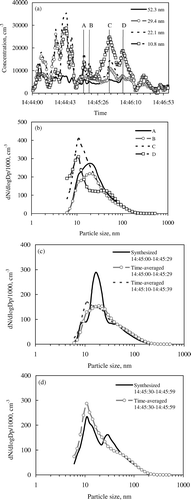
To illustrate the potential sampling artifact of a 30-s sizer, the dataset is used to synthesize the particle size distribution spectrum of a 30-s sequentially scanning 30-channel particle sizer by assuming that 1 s is needed to scan each channel. The concentration of each channel (size) is sequentially extracted from 30 sets of EEPS data (samples) to synthesize the spectrum, that is, the diagonal elements of a 30×30 channel concentration vs. time matrix are used. The synthesized size distributions are shown in and . The difference between the EEPS distributions and the synthesized spectrum is not very large for 14:45:30–14:45:59 () but they are quite different for 14:45:00–14:45:29. In the latter case, the modes and concentrations are all different. This is not surprising considering how the synthesized size distribution is constructed. As a matter of fact, it is not a spectrum but a collection of numbers, even though the individual cut-concentration is correct. Recently, EEPS was compared to SMPS in engine test-bed transient cycle particle emission measurements, and it was suggested that the SMPS was not suitable for such measurements. There was noticeable mode distortion in the SMPS measurements (http://www.tsi.com/documents/3090_2980244A.pdf).
Stretching this line of thinking a bit further, time-averaging of this kind of data could also cause problems, theoretically. Time-averaged (30 s) size distributions of these particles for the periods of 14:45:00–14:45:29 (containing Points A and B) and 14:45:30–14:45:59 (containing Points C and D) are in and , respectively. It can be seen from that the distributions of A and B are similar, and likewise, C and D are similar, therefore, time-averaging among themselves does not create much difference in the concentration and size distribution data. However, time-averaging B and C, two different distributions within a 30 s sampling span, produces a distribution that does not resemble any of the original distributions. This amounts to numerically mixing two different types of particles.
Additional results using MAP EEPS data collected on roads and inside tunnels, where particle concentrations are much higher than roadside, are presented in and to further substantiate our observation. The discrepancies are even greater and tri-modal distribution can be produced. Thus, this seems to be a situation when the particle size distribution variation is fast. To alleviate this situation when using a slow scanning sizer, care is to be taken to ensure that the variation in the particle concentration and size distribution is small.
FIG. 3 Ultrafine particle number concentrations and size distributions when MAP was traveling on road on 7 October 2004. (a) Concentrations (cm− 3) of 10.8, 22.1, 29.4, and 52.3 nm particles. (b) Number size distributions at specific times (marked as A, B, C and D). (c) Time-averaged and synthesized spectra for the period 11:28:00–11:28:29. (d) Time-averaged and synthesized spectra for the period 11:28:30–11:28:59.
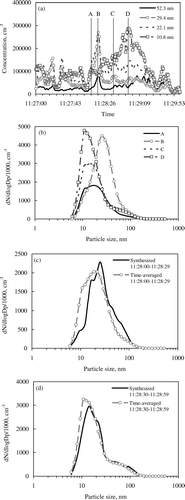
FIG. 4 Ultrafine particle number concentrations and size distributions in Tseung Kwan O Tunnel on 7 October 2004. (a) Concentrations (cm− 3) of 10.8, 22.1, 29.4, and 52.3 nm particles. (b) Number size distributions at specific times (marked as A, B, C, D, and E). (c) Time-averaged and synthesized spectra for the period 16:34:00–16:34:29. (d) Time-averaged and synthesized spectra for the period 16:34:30–16:34:59.
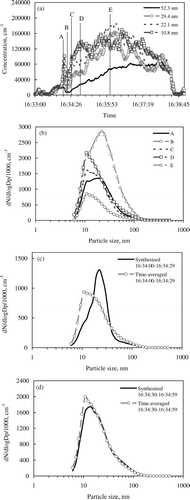
Similar analysis was made to simulate faster SMPS and 3- and 6-s synthesized spectra are shown in and . Based on MAP roadside and tunnel data, the 3-s synthesized spectra are generally consistent with the 1 s data with only 10% of the synthesized spectra having severe distortions, however, 60% of the 6-s synthesized spectra are distorted. This is because variations of particle spectra under these conditions were generally slower than 3 s, but the variations were mostly faster than 6s. Thus, under these conditions, 1-s time resolution sizer is probably fast enough to capture variations of particle spectra slower than 3 s, and the slow scanning particle sizers may be used in well dispersed (slow varying) environment.
Acknowledgments
This project is sponsored by the Hong Kong Jockey Club Charities Fund for which the team is grateful. TSI, Inc., USA generously loaned the EEPS (Model 3090) to the team without which this study would not be possible.
REFERENCES
- Biskos , G. , Reavell , K. and Collings , N. 2005 . Description and Theoretical Analysis of a Differential Mobility Spectrometer . Aerosol. Sci. Technol. , 39 : 527 – 541 . [CSA]
- Bukowiecki , N. , Kittelson , D. B. , Watts , W. F. , Burtsher , H. , Weingartner , E. and Baltensperger , U. 2002a . Real-Time Characterization of Ultrafine and Accumulation Mode Particles in Ambient Combustion Aerosols . J. Aerosol Sci. , 33 : 1139 – 1154 . [CSA] [CROSSREF]
- Bukowiecki , N. , Dommen , J. , Prévôt , A. S. H. , Richter , R. , Weingartner , E. and Baltensperger , U. 2002b . A Mobile Pollutant Measurement Laboratory—Measuring Gas Phase and Aerosol Ambient Concentrations with High Spatial and Temporal Resolution . Atmos. Environ. , 36 : 5569 – 5579 . [CSA] [CROSSREF]
- Bukowiecki , N. , Dommen , J. , Prévôt , A. S. H. , Richter , R. , Weingartner , E. and Baltensperger , U. 2003 . Fine and Ultrafine Particles in the Zürich (Switzerland) Area Measured with a Mobile Laboratory: An Assessment of the Seasonal and Regional Through a Year . Atmos. Chem. Phys. , 3 : 1477 – 1494 . [CSA]
- Burtscher , H. 2005 . Physical Characterization of Particulate Emissions from Diesel Engines: A Review . J. Aerosol Sci. , 36 : 896 – 932 . [CSA] [CROSSREF]
- Collins , D. R. , Flagan , R. C. and Seinfeld , J. H. 2002 . Improved Inversion of Scanning DMA Data . Aerosol Sci. Technol. , 36 : 1 – 9 . [CSA] [CROSSREF]
- Coombs , C. F. 1995 . Electronic Instrument Handbook , 2nd Edition , New York : MacGraw-Hill .
- Desantes , J. M. , Bermúdez , V. , García , J. M. and Fuentes , E. 2005 . Effects of Current Engine Strategies on the Exhaust Aerosol Particle Size Distribution from a Heavy-Duty Diesel Engine . J. Aerosol Sci. , 36 : 1251 – 1276 . [CSA] [CROSSREF]
- Gidhagen , L. , Johansson , C. , Ström , J. , Kristensson , A. , Swietlicki , E. , Pirjola , L. and Hansson , H. C. 2003 . Model Simulation of Ultrafine Particles Inside a Road Tunnel . Atmos. Environ. , 37 : 2023 – 2036 . [CSA] [CROSSREF]
- Gramotnev , D. K. and Gramotnev , G. 2005 . A New Mechanism of Aerosol Evolution Near a Busy Road: Fragmentation of Nanoparticles . J. Aerosol Sci. , 36 : 323 – 340 . http://www.tsi.com/documents/3090_2980244A.pdf [CSA] [CROSSREF]
- Jacobson , M. Z. , Kittelson , D. B. and Watts , W. F. 2005 . Enhanced Coagulation Due to Evaporation and its Effect on Nanoparticle Evolution . Environ. Sci. Technol. , 39 : 9486 – 9492 . [INFOTRIEVE] [CSA] [CROSSREF]
- Johnson , T. , Caldow , R. , Pocher , A. , Mirme , A. and Kittelson , D. B. 2004 . A New Electrical Mobility Particle Sizer Spectrometer for Engine Exhaust Particle Measurements 01 – 1341 . SAE-2004-
- Kittelson , D. B. , Watts , W. F. and Johnson , J. P. 2004 . Nanoparticle Emissions on Minnesota Highways . Atmos. Environ. , 38 : 9 – 19 . [CSA] [CROSSREF]
- Knutson , E. O. and Whitby , K. T. 1975 . Aerosol Classification by Electric Mobility: Apparatus, Theory, and Applications . J. Aerosol. Sci. , 6 : 433 – 451 . [CSA] [CROSSREF]
- Kuhn , T. , Krudysz , M. , Zhu , Y. , Fine , P. M. , Hinds , W. C. , Froines , J. and Sioutas , C. 2005 . Volatility of Indoor and Outdoor Ultrafine Particulate Matter Near a Freeway . J. Aerosol Sci. , 36 : 291 – 302 . [CSA] [CROSSREF]
- Molnár , P. , Janhäll , S. and Hallquist , M. 2002 . Roadside Measurements of Fine and Ultrafine Particles at a Major Road North of Gothenburg . Atmos. Environ. , 36 : 4115 – 4123 . [CSA] [CROSSREF]
- Shah , S. D. and Cocker , D. R. 2005 . A Fast Scanning Mobility Particle Spectrometer for Monitoring Transient Particle Size Distributions . Aero. Sci. Technol. , 39 : 519 – 526 . [CSA]
- Sturm , P. J. , Baltensperger , U. , Bacher , M. , Lechner , B. , Hausberger , S. , Heiden , B. , Imhof , D. , Weingartner , E. , Prevot , A. S. H. , Kurtenbach , R. and Wiesen , P. 2003 . Roadside Measurements of Particulate Matter Size Distribution . Atmos. Environ. , 37 : 5273 – 5281 . [CSA] [CROSSREF]
- Tammet , H. , Mire , A. and Tamm , E. 2002 . Electrical Aerosol Spectrometer of Tartu University . Atmos. Res. , 62 : 315 – 324 . [CSA] [CROSSREF]
- Wang , S. C. and Flagan , R. C. 1989 . Scanning Electrical Mobility Spectrometer . J. Aerosol Sci. , 20 : 1485 – 1488 . [CSA] [CROSSREF]
- Wang , J. , McNeill , V. F. , Collins , D. R. and Flagan , R. C. 2002 . Fast Mixing Condensation Nucleus Counter: Application to Rapid Scanning Differential Mobility Analyzer Measurements . Aero. Sci. Technol. , 36 : 678 – 689 . [CSA] [CROSSREF]
- Yao , X. H. , Lau , N. T. , Fang , M. and Chan , C. K. 2005 . Real-Time Observation of the Transformation of Ultrafine Atmospheric Particle Modes . Aerosol. Sci. Technol. , 39 : 831 – 841 . [CSA] [CROSSREF]
- Zhu , Y. , Hinds , W. C. , Kim , S. , Shen , S. and Sioutas , C. 2002a . Study of Ultrafine Particles Near a Major Highway with Heavy-Duty Diesel Traffic . Atmos. Environ. , 36 : 4323 – 4335 . [CSA] [CROSSREF]
- Zhu , Y. , Hinds , W. C. , Kim , S. and Sioutas , C. 2002b . Concentration and Size Distributions Ultrafine Particles Near a Major Highway . J. Air and Waste Manage. Asso. , 52 : 1032 – 1042 . [CSA]
